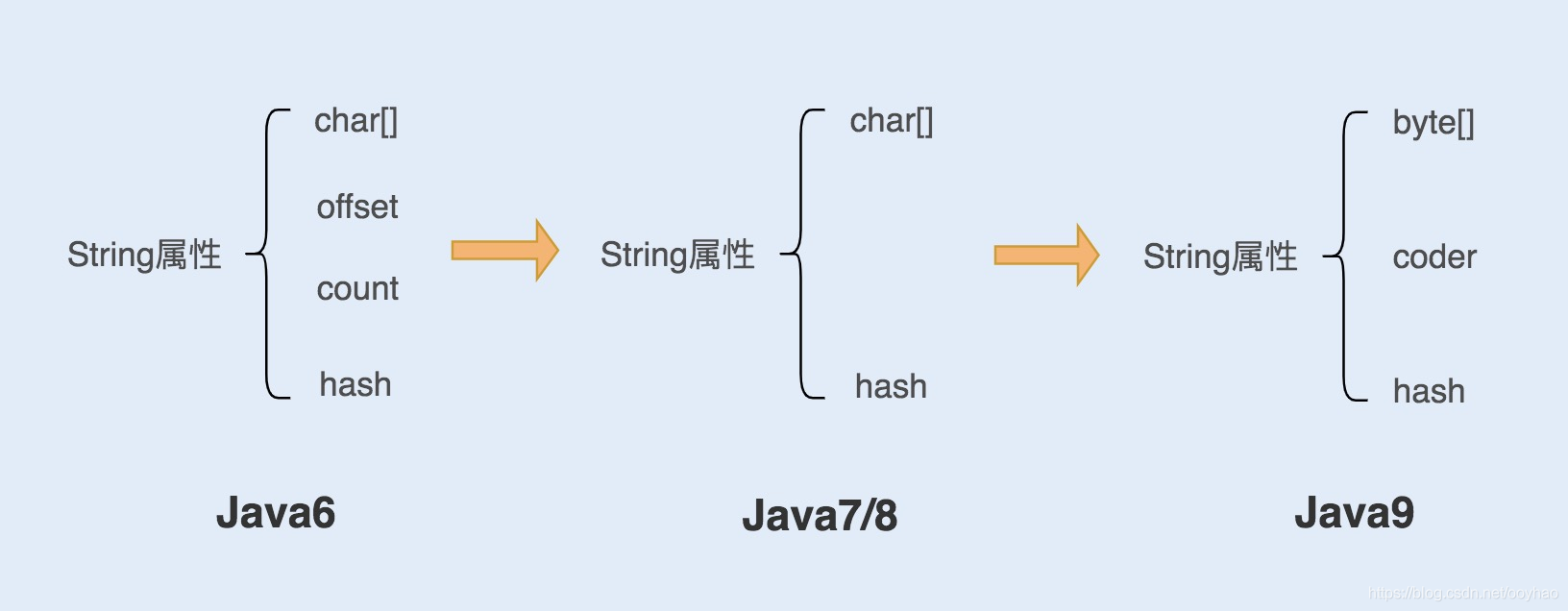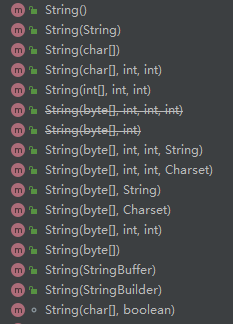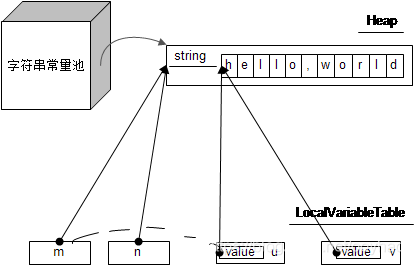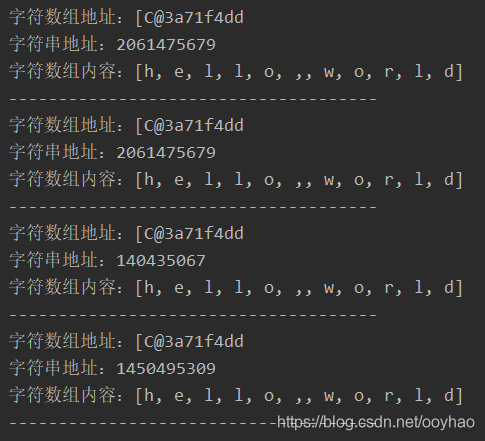| 阿里云国内75折 回扣 微信号:monov8 |
| 阿里云国际,腾讯云国际,低至75折。AWS 93折 免费开户实名账号 代冲值 优惠多多 微信号:monov8 飞机:@monov6 |
String 类
定义
String类是一个不可变类。其一旦被赋值,就不能被修改了。
我们先来看一下源码:
public final class String implements java.io.Serializable, Comparable<String>, CharSequence {
private final char value[];
private int hash;
}我们都知道String类是一个不可变类。首先String类是被final修饰的类,不能被任何类继承,而且由于内部属性value数组也被final修饰,一旦被创建之后,包含在这个对象中的字符序列是不可改变的,包括该类后续的所有方法都是不能修改该对象的,直至该对象被销毁,这是我们需要特别注意的(该类的一些方法看似改变了字符串,其实内部都是创建一个新的字符串)。
通过上面的代码可以看到,String内部其实是一个字符数组char[] ,这里使用的JDK版本是8.x的。在后面的版本改为了byte[]数组,网上说9.x之后改的。我没有下载9.x,看的是11.x,内部确实改为了byte[].
网上扯来了一张图:

看完String类的基本特点之后,我们看一下方法:
构造方法
String类的构造方法有很多,我们来看一下:

无参构造方法:
public String() {
this.value = "".value;
}字符串构造方法:
public String(String original) {
this.value = original.value;
this.hash = original.hash;
}以及利用字符数组,字节数组 和 StringBuffer 以及 StringBuilder来创建。
示例:
String str0 = new String();
String str1 = new String("abc");
String str2 = new String(new char[]{'a', 'b', 'c'});
String str3 = new String(new byte[]{1, 2, 3});
String str4 = new String(new StringBuilder());
String str5 = new String(new StringBuffer());
除了上面的示例,还有一些特殊处理的。比如取数组的某个区间创建字符串。
常用的普通方法
获取长度和判空的方法
public int length() {
return value.length;
}
public boolean isEmpty() {
return value.length == 0;
}获取当前字符串中指定位置的字符
说明:通过其源码可以看出,其实就是获取value数组第index位置上的字符。由于数组下标从0开始,所以这里的index也是从0开始的。
public char charAt(int index) {
if ((index < 0) || (index >= value.length)) {
throw new StringIndexOutOfBoundsException(index);
}
return value[index];
}获取字符串的字节数组
public byte[] getBytes(String charsetName) throws UnsupportedEncodingException {}
public byte[] getBytes(Charset charset) {}
public byte[] getBytes() {}比较字符串是否相同
通过方法名即可知道equalsIgnoreCase是忽略大小写的,则equals是区分大小写的比较,即A 和 a 是false
public boolean equals(Object anObject) {}
public boolean equalsIgnoreCase(String anotherString) {}比较字符串大小,返回值是int
public int compareTo(String anotherString) {}
public int compareToIgnoreCase(String str) {}以xx开头,以xx结尾
实用场景:
- startsWith:比如判断某一类路径,不走拦截器拦截,以/static开头的静态文件不拦截。
- endsWith:比如获取所有的pdf文件,那就需要判断是否是以.pdf结尾的。
public boolean startsWith(String prefix, int toffset) {}
public boolean startsWith(String prefix) {}
public boolean endsWith(String suffix) {}获取指定元素的下标
获取指定字符,指定字符串第一次出现的位置,最后一次出现的位置。
public int indexOf(int ch) {}
public int indexOf(int ch, int fromIndex) {}
public int lastIndexOf(int ch) {}
public int lastIndexOf(int ch, int fromIndex) {}
public int indexOf(String str) {}
public int indexOf(String str, int fromIndex) {}
public int lastIndexOf(String str) {}
public int lastIndexOf(String str, int fromIndex) {}这里需要注意,我们的方法中只提供 int和String类型的参数,但是我们可以传入char类型的,这里就涉及到了类型转换问题:
String str = "abcda";
System.out.println(str.indexOf('a')); //0
System.out.println(str.lastIndexOf('a')); //4
System.out.println(str.indexOf(98)); //1
System.out.println(str.lastIndexOf(99)); //2
System.out.println(str.indexOf("bc")); //1
System.out.println(str.lastIndexOf("bc")); //1
类型转换:左边的类型可以自动类型转换为右边的类型,反过来则需要强制类型转换。
- byte -> short -> int -> long -> float -> double
- char -> int -> long -> float -> double
子串subString
public String substring(int beginIndex) {
if (beginIndex < 0) {
throw new StringIndexOutOfBoundsException(beginIndex);
}
int subLen = value.length - beginIndex;
if (subLen < 0) {
throw new StringIndexOutOfBoundsException(subLen);
}
return (beginIndex == 0) ? this : new String(value, beginIndex, subLen);
}
public String substring(int beginIndex, int endIndex) {
if (beginIndex < 0) {
throw new StringIndexOutOfBoundsException(beginIndex);
}
if (endIndex > value.length) {
throw new StringIndexOutOfBoundsException(endIndex);
}
int subLen = endIndex - beginIndex;
if (subLen < 0) {
throw new StringIndexOutOfBoundsException(subLen);
}
return ((beginIndex == 0) && (endIndex == value.length)) ? this
: new String(value, beginIndex, subLen);
}可以看出,subString方法是获取指定区间的字符数组新创建String或是返回当前字符串本身。
字符串拼接
public String concat(String str) {
int otherLen = str.length();
if (otherLen == 0) {
return this;
}
int len = value.length;
char buf[] = Arrays.copyOf(value, len + otherLen);
str.getChars(buf, len);
return new String(buf, true);
}通过方法可以知道,方法体直接调用的是length方法,所以传入的参数不能为空,否则会抛出空指针异常。字符串拼接,会返回一个新的字符串对象,不会修改原来数据。
字符串替换
具体实现先不看,直接看返回值,可以看出,同样是方法当前对象或是重新构建一个新的对象。
解释:
- replace: 单个字符替换,将所有相同的字符全部替换
- replaceFirst: 见名知意,替换第一个相同的字符串
- replaceAll:同样,将所有相同的字符串全部替换,只是replaceFirst和replaceAll支持正则表达式。
- replace:则是CharSequence类型的参数。下面是CharSequence的实现类。

public String replace(char oldChar, char newChar) {}
public String replaceFirst(String regex, String replacement) {}
public String replaceAll(String regex, String replacement) {}
public String replace(CharSequence target, CharSequence replacement) {}我们看其中一个方法;
说明:从源码我们可以知道,返回值是一个新的对象或是本身,同时会把所有相同的对象全部替换。
public String replace(char oldChar, char newChar) {
if (oldChar != newChar) {
int len = value.length;
int i = -1;
char[] val = value; /* avoid getfield opcode */
while (++i < len) {
if (val[i] == oldChar) {
break;
}
}
if (i < len) {
char buf[] = new char[len];
for (int j = 0; j < i; j++) {
buf[j] = val[j];
}
while (i < len) {
char c = val[i];
buf[i] = (c == oldChar) ? newChar : c;//一直遍历到最后,所以会把相同的串全部替换
i++;
}
return new String(buf, true);
}
}
return this;
}判断字符串是否满足格式
public boolean matches(String regex) {}可以看出,接受一个正则表达式串,来判断当前字符串是否满足格式。
判断字符串是否包含指定子串
public boolean contains(CharSequence s) {}分割字符串
public String[] split(String regex, int limit) {}
public String[] split(String regex) {}转换大小写
public String toLowerCase(Locale locale) {}
public String toLowerCase() {}
public String toUpperCase(Locale locale) {}
public String toUpperCase() {}去除空白符
同样没有修改原有的字符,调用的是subString方法,用来获取子串,也是新创建的字符串对象。
public String trim() {
int len = value.length;
int st = 0;
char[] val = value;
while ((st < len) && (val[st] <= ' ')) {
st++;
}
while ((st < len) && (val[len - 1] <= ' ')) {
len--;
}
return ((st > 0) || (len < value.length)) ? substring(st, len) : this;
}加分隔符并返回字符串
public static String join(CharSequence delimiter, CharSequence... elements) {}
public static String join(CharSequence delimiter, Iterable<? extends CharSequence> elements) {}实例:
List<String> stringList = new ArrayList<>();
stringList.add("AA");
stringList.add("BB");
stringList.add("CC");
String join = String.join("|", stringList);
System.out.println(join);// AA|BB|CC
System.out.println(String.join("@","A","B","C"));// A@B@C
获取字符串的字节数组
public char[] toCharArray() {
// Cannot use Arrays.copyOf because of class initialization order issues
char result[] = new char[value.length];
System.arraycopy(value, 0, result, 0, value.length);
return result;
}其他类型转为字符串
public static String valueOf(Object obj) {}
public static String valueOf(char data[]) {}
public static String valueOf(char data[], int offset, int count) {}
public static String copyValueOf(char data[], int offset, int count) {}
public static String copyValueOf(char data[]) {}
public static String valueOf(boolean b) {}
public static String valueOf(char c) {}
public static String valueOf(int i) {}
public static String valueOf(long l) {}
public static String valueOf(float f) {}
public static String valueOf(double d) {}功能就是将传入的参数转为字符串,这里不详细说。
注意:我们基本把String中的方法都看遍了,可以发现,String内部都没有去修改原有字符串的内容,由于要维护字符串的不可变性,所以转替换,转大小写,删空白符等操作,都是通过新建String对象来实现的。
String为什么是不可变类
上面我们介绍了如何保证String类是不可变类:①利用final关键字修饰String类,这样String就不能被继承,就无法被继承修改。②利用final修改属性value,就意味着value属性一旦初始化,就不可以修改。
但是我们都知道value属性是一个数组,虽然我们不能修改value属性的引用,但是我们可以修改数组中具体的某个下标元素,如下:
final int val[] = {1,23,3};
val[1] = 20;//[1, 20, 3]也就是说,要实现真正的不可变类String,并不会仅仅因为这两个final关键字修饰。通过上面我们分析的普通方法可以知道,所以设计到修改字符串的方法,都是构建了新的字符串实例之后返回的,也就是JDK设计者在设计的时候,已经保证了所提供的方法是不会修改value数组的数据的。所以,综合上述三个条件,才能实现真正的不可变类。如下:
- final修饰类:保证String类无法被继承,从而无法通过重写方法来修改原有String类的方法功能。
- final修饰value:保证value属性一旦被初始化,其引用就是固定的,不能修改。
- 方法不修改value数组的具体元素:保证在使用String提供的方法时,都不会修改String内部的数据。
String类为什么要设计成不可变类
原因:
- 安全
- hashcode缓存的需要
- 实现字符串常量池(效率高)
安全
如果字符串可变的话,可能会引发安全问题,比如数据库的用户名、密码都是以字符串的形式传入来获得数据库的连接,或者在socket变成中,主机和端口都是以字符串的形式传入的。因为字符串是不可变的,所以它的值是不可以变的,否则黑客可以钻到空子,改变字符串指向的对象的值,造成安全漏洞。
hashcode缓存的需要
首先我们需要先看一下String类的hashcode的计算方法:
private int hash; // Default to 0
public int hashCode() {
int h = hash;
if (h == 0 && value.length > 0) {
char val[] = value;
for (int i = 0; i < value.length; i++) {
h = 31 * h + val[i];
}
hash = h;
}
return h;
}
可以看到,hashcode只在第一次进行计算,后续调用这个对象时,直接返回缓存在对象中的hash值。hashcode的计算与value有关,若String可变,那么hashcode也需要随之进行计算,针对于Map,Set等容器,他们的键值需要保证唯一性和一致性,因此,String的不可变性使其比其他对象更加适合当容器的键值对。
实例:如果我们不用String类型的不可变类来存,而使用StringBuilder这种可变类来操作,往HashSet中存值,如下:
public static void main(String[] args) {
StringBuilder sb1 = new StringBuilder("AA");
StringBuilder sb2 = new StringBuilder("AA");
HashSet<StringBuilder> set = new HashSet<>();
set.add(sb1);
set.add(sb2);
System.out.println(set);//[AA, AA]
}可以看出,想StringBuilder这种没有重写hashcode方法,调用的Object的。把sb1和sb2进行了区分,这对于我们来说就相当于存储了相同的值。
实现字符串常量池
这个原因是非常主要的,只有保证了字符串类的不可变性,才有实现字符串常量池的必要性。
常量池:Java运行时会维护一个String Pool(String池),也叫“字符串缓存池”。String池用来存放运行时中产生的各种字符串,并且池中的字符串的内容不重复。
①、字面量创建字符串或者纯字符串(常量)拼接字符串会现在字符串池中找,看是否有相等的对象,没有的话就在字符串池创建该对象;有的话则直接用池中的引用,避免重复创建对象。
②、new关键字创建时,直接在堆中创建一个新的对象,变量所引用的都是这个新对象的地址,但是如果new关键字创建的字符串内容在常量池中存在了,那么会由堆再指向常量池中对应的字符;但是反过来,如果通过new关键字创建的字符串对象在常量池中没有,那么通过new关键字创建的字符串对象是不会额外在常量池中维护的。
③、使用包含变量表达式来创建String对象,则不仅会检查维护字符串池,还会在堆区创建这个对象,最后是指向堆内存的对象。
我们先来看一个题目:
String str1 = "hello";
String str2 = "hello";
String str3 = new String("hello");
System.out.println(str1==str2);
System.out.println(str1==str3);
System.out.println(str2==str3);
System.out.println(str1.equals(str2));
System.out.println(str1.equals(str3));
System.out.println(str2.equals(str3));

首先,str1是字面量创建对象的,所以会先看字符串常量池中查看有没有"hello"对象,发现没有,会先在字符串常量池中创建,再将其引用返回,而此时str2创建时,字符串常量池中已经存在了,所以就直接返回"hello"对象的引用。当str3通过new对象创建时,会先在堆中创建对象,然后查询常量池,发现里面存在了"hello"对象,于是将其指向字符串常量池中的对象。
我们再来看一个题目:
public static void main(String[] args]{
String str1 = "hello";
String str2 = "helloworld";
String str3 = str1+"world";
String str4 = "hello"+"world";
System.out.println(str2==str3);
System.out.println(str2==str4);
System.out.println(str3==str4);
}上面的结果是什么呢?
我们先看一下反编译之后的结果:
public static void main(String[] args) {
String str1 = "hello";
String str2 = "helloworld";
String str3 = str1 + "world";
String str4 = "helloworld";
System.out.println((str2 == str3));
System.out.println((str2 == str4));
System.out.println((str3 == str4));
}首先 str1 是利用字符串字面量来创建对象。str2也是。可以看出,str4编译器能够明确这两个是不变的,就进行优化了,而str3中带有str1,编译器是无法确定里面的值的。
对于str1,内存操作步骤是:
先查询字符串常量池用存不存在"hello"对象。
- 存在,直接返回字符串常量池中"hello"对象的引用
- 不存在,在字符串常量池中创建"hello"对象,并返回其引用。
str2 依旧如此。那么此时字符串常量池中已经有"hello"对象和"helloworld"对象了。当执行到str3时,由于此时不是字面量创建了,str3会先在堆内存中创建一个String对象,再去查询str1+world拼接后的"helloworld"对象是否存在于字符串常量池中,如果存在,则直接将str3中的对象指向常量池中"helloworld"对象的。如果不存在,则只会在堆中创建。
而当执行str4时,其实与str2的效果一样,同样是直接查询常量池。如图:

至此,我们再回来看这个题目:
public static void main(String[] args]{
String str1 = "hello";
String str2 = "helloworld";
String str3 = str1+"world";
String str4 = "hello"+"world";
System.out.println(str2==str3);//false
System.out.println(str2==str4);//true
System.out.println(str3==str4);//false
}可能看到这,会有这样的疑惑,堆中创建了对象怎么再指向常量池呢?
字符串对象内部是用字符数组存储的,那么看下面的例子:
String m = "hello,world";
String n = "hello,world";
String u = new String(m);
String v = new String("hello,world");
System.out.println(m == n);
System.out.println(m == u);
System.out.println(m == v);
System.out.println(u == v);
- 会分配一个11长度的char数组,并在常量池分配一个由这个char数组组成的字符串,然后由m去引用这个字符串。
String m = "hello,world"
- 用n去引用常量池中的字符串对象,所以和m引用的是同一个对象。
- 在堆中生成一个新的字符串,但是其内部的字符数组是引用m内部的字符数组。
- 同样会生成一个新的字符串,但内部的字符数组引用常量池中的m的字符数组,意思是和u是同样的字符数组。
图示:情况就大概是这样的(使用虚线只是表示两者其实没什么特别的关系)

综上,所以题目结果为:
System.out.println(m == n);//true
System.out.println(m == u);//false
System.out.println(m == v);//false
System.out.println(u == v);//false
结论:
- m和n是同一个对象。
- m,u,v都是不同的对象
- m,n,u,v都使用了同样的字符数组,并且用equals判断的话也会返回true。
上面说到了m,n,u,v都是使用了同样的字符数组,但是我们使用正常的方式又获取不到value属性,那么我们使用反射来看一下具体的地址和值。
public static void main(String[] args) throws Exception {
String m = "hello,world";
String n = "hello,world";
String u = new String(m);
String v = new String("hello,world");
Field value = String.class.getDeclaredField("value");
value.setAccessible(true);
printMsg(m, value);
printMsg(n, value);
printMsg(u, value);
printMsg(v, value);
}
private static void printMsg(String m,Field value) throws IllegalAccessException {
Object o = value.get(m);
System.out.println("字符数组地址:"+o);
System.out.println("字符串地址:"+System.identityHashCode(m));
System.out.println("字符数组内容:"+Arrays.toString((char[])o));
System.out.println("-------------------------------------");
}结果如图:

可以看到获取到m,n,u,v四个对象中的char[] value数组的地址都是相同的。m和n的地址也是一样的
可变的String
String类的字符数组真的修改不了吗?String对象真的是一个绝对的不可变对象吗?不!下面我们来看一下,如果真的需要修改,如何修改String对象。
定义一个字符串String str = "hello"; 如果将其值修改为Hello;这里说的是真正的修改,str的地址不能变。
修改实例:
public static void main(String[] args) throws Exception {
String str = "hello";
//获取所有的value属性
Field value = String.class.getDeclaredField("value");
//设置为可访问
value.setAccessible(true);
//获取属性值
Object o = value.get(str);
//转为字符数组
char[] val = (char[]) o;
//修改字符数组
val[0] = 'H';
System.out.println(str);//Hello
}如上所示,可以进行字符串内容的修改,但是需要使用到反射技术。但是一般不会进行这样的操作,所以可以说String类是不可变的类。
| 阿里云国内75折 回扣 微信号:monov8 |
| 阿里云国际,腾讯云国际,低至75折。AWS 93折 免费开户实名账号 代冲值 优惠多多 微信号:monov8 飞机:@monov6 |








